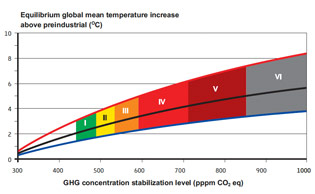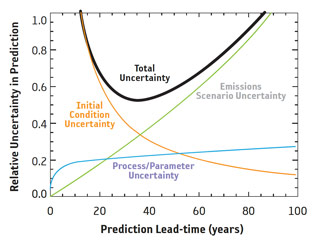 |
|
 |
| FUTURE CLIMATE TRENDS AND IMPACTS |
 |
The IPCC’s Fourth Assessment Report notes that the scientific evidence on the causes and future trends of climate change is strengthening all the time and that scientists are able to attach probabilities to the temperature outcomes and impacts on the natural environment associated with different levels of stabilisation of greenhouse gases in the atmosphere.
The current stock of greenhouse gases in the atmosphere is equivalent to around 430 parts per million (ppm) CO2, compared with only 280 ppm before the Industrial Revolution. These concentrations have already caused the world to warm by more than half a degree Celsius and will lead to at least a further half degree warming over the next few decades, because of the inertia in the climate system.
Even if the annual flow of emissions did not increase beyond today’s rate, the stock of greenhouse gases in the atmosphere would reach double pre-industrial levels by 2050 – that is 550 ppm CO2e (CO2 equivalent) – and would continue growing thereafter. But the annual flow of emissions is accelerating, as fast-growing economies invest in high carbon infrastructure and as demand for energy and transport increases around the world. The level of 550 ppm CO2e could be reached as early as 2035. At this level there is at least a 77% chance – and perhaps up to a 99% chance, depending on the climate model used – of a global average temperature rise exceeding 2°C.
Under a ‘business as usual’ scenario, the stock of greenhouse gases could more than treble by the end of the century, giving at least a 50% risk of exceeding 5°C global average temperature change during the following decades. This would take humans into unknown territory. An illustration of the scale of such an increase is that the global average temperature is now only around 5°C warmer than in the last ice age |
 |
 |
 |
Predicted global temperature increase under different scenarios of CO2 equivalent stabilisation levels.
(From IPCC 2007 WG III report) |
|
 |
Such changes would transform the Earth’s physical geography, with dramatic implications for the human geography – where people live, and how they live their lives. The figure above (based on IPCC data) summarises the scientific
evidence of the links between concentrations of greenhouse gases in the atmosphere, the probability of different levels of global average temperature change, and the physical impacts expected for each level. The risks of serious, irreversible impacts of climate change increase strongly as concentrations of greenhouse gases in the atmosphere rise.
Warming will have many severe impacts, often mediated through water:
— melting glaciers will initially increase flood risk and then strongly reduce water supplies, eventually threatening one-sixth of the world’s population, predominantly in the Indian sub-continent, parts of China, and the Andes in South America;
— declining crop yields, especially in Africa, could leave hundreds of millions without the ability to produce or purchase sufficient food. At mid to high latitudes, crop yields may increase for moderate temperature rises (2 – 3°C), but then decline with greater warming. At 4°C and above, global food production is likely to be seriously affected;
— in higher latitudes, cold-related deaths will decrease. But climate change will increase worldwide deaths from malnutrition and heat stress. Vector-borne diseases such as malaria and dengue fever could become more widespread if effective control measures are not in place;
— with warming of 3 or 4°C, rising sea levels will result in tens to hundreds of millions more people being flooded each year. There will be serious risks and increasing pressures for coastal protection in South East Asia (Bangladesh and Vietnam), small islands in the Caribbean and the Pacific, and large coastal cities, such as Tokyo, New York, Cairo and London. According to one estimate, by the middle of the century, 200 million people may become permanently displaced due to rising sea levels, greater floods, and more intense droughts;
|
|
 |
 |
 |
| Global meltdown. A tipping point is the place of no return. This map shows the risk of different tipping points being passed this century if global warming continues at 3-5°C. |
 |
— ecosystems will be particularly vulnerable to climate change, with around 15 – 40% of species potentially facing extinction after only 2°C of warming. Ocean acidification, a direct result of rising carbon dioxide levels, will have major effects on marine ecosystems, with possible adverse consequences on fish stocks.
In other words, climate change threatens the basic elements of life for people around the world – access to water, food production, health, and use of land and the environment. Significantly, the damage from climate change will accelerate as the world gets warmer, with higher temperatures increasing the chance of triggering abrupt and large-scale changes.
Climate scientists [1] have identified areas that they consider to be in gravest danger of passing critical thresholds or ‘tipping points’, beyond which they will not recover. Their assessment concluded:
— Arctic sea ice will go into irreversible decline once temperatures rise between 0.5°C and 2°C above those at the beginning of the century, a threshold that may already have been crossed;
— there is already a 50% chance that the Greenland ice sheet will soon begin melting unstoppably, although it could take hundreds of years to melt completely. The meltwater could raise global sea levels by seven metres;
— a temperature rise of 3°C could see more intense El Niños, with possible profound effects on the weather from Africa to North America;
— warming of 3°C to 5°C could reduce rainfall in the Amazon by 30%, lengthening the dry season and threatening to kill large areas of trees that will not re-establish themselves;
— the Boreal forests could also pass their tipping point, with large swaths dying off over the next 50 years;
— in Africa, more rainfall may re-green the Sahel region, but the west African monsoon could collapse, leading to twice as many unusually dry years by the end of the century;
— the Indian summer monsoon is predicted to become erratic and, in the worst case scenario, begin to flip chaotically, unleashing flash floods one year and droughts the next;
|
|
|
— measurements of the western Antarctic ice sheet show the balance of snowfall and melting has shifted and it is now shrinking. Local warming of more than 5°C could trigger uncontrollable melting, adding 5 metres to sea levels within 300 years;
— under the same warming, Atlantic currents that power the Gulf Streamcould be severely disrupted. While there is much to learn about these risks, the temperatures that may result from unabated climate change could take the world outside the range of human experience.
Uncertainty in climate predictions is the critical element in IPCC considerations of mitigation and adaptation strategies to cope with changing climate. This problem is easily seen in the first diagram below, taken from the IPCC 2007 report, where the predicted increase in global temperatures is shown for a range of greenhouse gas concentration stabilisation levels (I–VI). Within each of the scenarios it is clear that there is considerable uncertainty, of the same order as the predicted change in mean temperature. Reducing this uncertainty is the key challenge in climate modelling today, and the aspect of prediction which will have the greatest impact on policy.
It has been shown (Cox and Stephenson, Science, July 2007 – summarised in the figure below) that the major element of uncertainty in climate predictions up to 30 years into the future is the lack of adequate information on initial conditions – i.e. lack of quality observations. If, therefore, we wish to reduce the uncertainty in climate predictions over this period, the primary need is for more and better observations, of which many are derived from satellites. |
 |

1 Lenton et al., Feb 2008. |
|
| |
|





